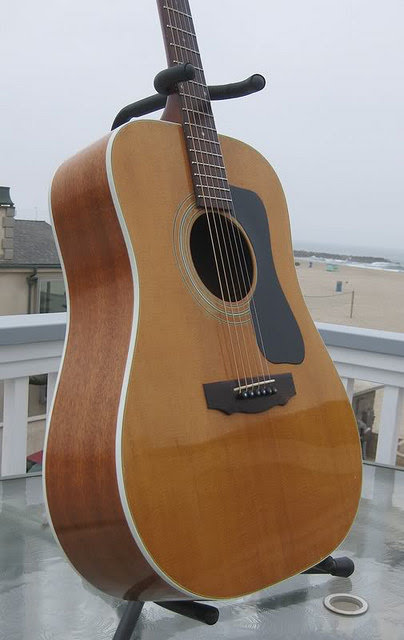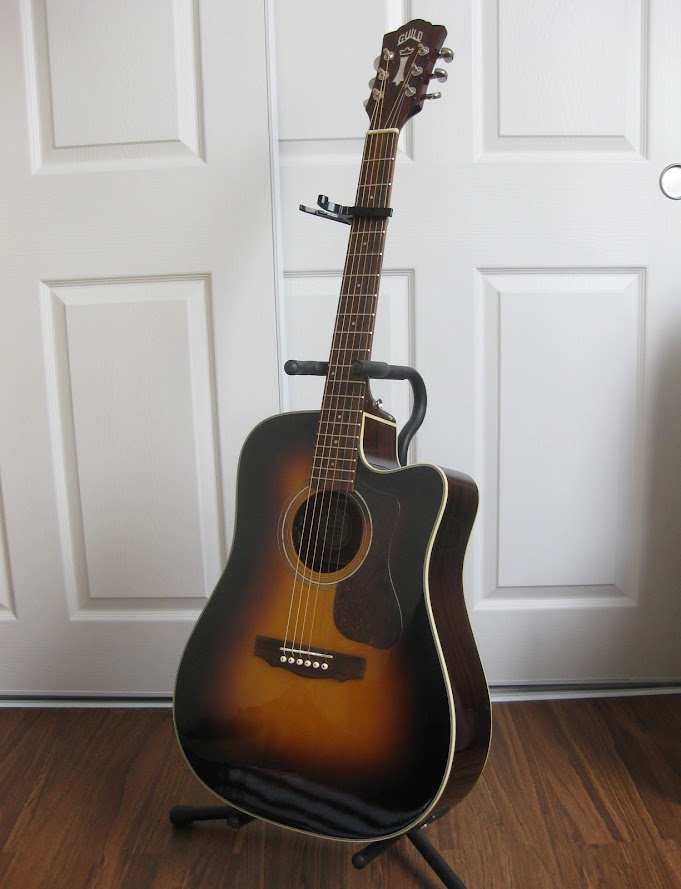Don't forget the Waverly decade... I've heard it was a disaster. 
You are using an out of date browser. It may not display this or other websites correctly.
You should upgrade or use an alternative browser.
You should upgrade or use an alternative browser.
A Confession (Hoboken vs. Westerly)
- Thread starter donnylang
- Start date
donnylang
Member
I think the objective change would be, beginning around 1973, Guilds began to get heavier. While I think the idea that heavy=bad can be challenged, I would say it’s probably factual that the change to heavier guitars was not in an effort to improve sound quality (whether or not they were able to maintain sound quality with the heavier builds). I think there are some old threads around that show how bracing patterns changed around that time too?When people talk about bad years for a consumer product I usually understand that to mean when something bad was going on and products from those years should be avoided. Most of the time "bad" is more objective than subjective. Poor design. "wrong" choices on specs. Inadequate quality inspection/control/assurance. Unreliable sub-components. Etc. Think of the auto issue of Consumer Reports where there are lists of used car brands, models and years to avoid, usually based on repair history and sometimes on the absence of specific (usually safety) features.
So by that definition I don't think Guild has had a bad decade.
That is not to say that if someone has a subjective response to specific features they might find it on some decades more than others, but that is as much about someone's preferences as it is about what Guild was doing.
How seriously would someone take me if I claimed the only good decade Guild had was the 1960's and based my comments on the availability of a Bisonic equipped bass?
D30Man
Senior Member
Aaaah Gibson’s bedeviled Norlin era. I owned a cracked out ‘73-‘75 J50 for about a year. It was a dog in every sense of the word. It had some beat up visual mojo but not enough tone mojo to make up for its tortoise binding deterioration and top cracks. I had its neck reset for $200. The guitar cost me $450. I barely broke even when selling. I think I got about $725 for it.Almost every '70s Gibson I've played was a total dog (and the late '60s ones not so great either). I think '70s Martins are decent IME, but their late '60s guitars were better. I know Martin supposedly had lots of quality issues in that era, and I had a '67 D12-20 where the saddle/bridge was misplaced, which I hear was one of the common issues. Once that issue was corrected, it was a great guitar though.
I agree Guilds are consistent across the board from what I’ve played- and certainly the post-‘72 periods were not “bad”, those guitars just haven’t spoken to me as much- though I will say I liked my ‘75 F50 more than the ‘71 F50 I had. So you never know.
Guitars from the Norlin era were made from 1970-1985.. When Gibson was owned by a co. with major interests in Beer and Concrete.. said to be the worst era for Gibson. Based on my experience I would have to agree.
I must say I picked my new '76 D25M over the comparable Gibson and Martin dreads after playing and inspecting all three. The beauty of the mahogany back was one the major selling points for me.
fronobulax
Bassist, GAD and the Hot Mess Mods
- Joined
- May 3, 2007
- Messages
- 24,748
- Reaction score
- 8,881
- Location
- Central Virginia, USA
- Guild Total
- 5
I think the objective change would be, beginning around 1973, Guilds began to get heavier. While I think the idea that heavy=bad can be challenged, I would say it’s probably factual that the change to heavier guitars was not in an effort to improve sound quality (whether or not they were able to maintain sound quality with the heavier builds). I think there are some old threads around that show how bracing patterns changed around that time too?
Heavier guitars starting in 1973 is a fact. But whether that is the beginning of a Good Decade or a Bad one depends upon whether someone thinks heavier guitars are Bad, or not. Because I am weird like that if you said "What is a Bad Decade for Guilds?" you would get one answer but if you said "I don't like heavy guitars. What is a Bad Decade for Guilds?" you get a different answer from. me.
The question is awkward for Guild because Guild was inconsistent. Just look at what happens when someone asks about buying a used F30? The question gets answered with more questions since the specs changed over the years.
Br1ck
Senior Member
Gibsons became hit or miss throughout the decade of the sixties. Earlier years had a better chance of being good. The 62 J 45 I played was quite nice if not up to 50s and before standards. Mind you, Gibsons always varied guitar to guitar moe than others, but late 40s through the 50s was just which very good you wanted. Get far into the sixties, it became a good, bad situation. I remember my eyes lighting up when I saw another Texan in the store not two months after I bought mine. It was a 68 and turned out to be truly 70sish. So dissabointing.
I can't recall ever having that feeling with a Guild, though I very much have my favorites.
I can't recall ever having that feeling with a Guild, though I very much have my favorites.
I think they did a great job in the '90's under Fender. Lots of great guitars including my son's '99 DV52.
swiveltung
Member
Me too.
Andrew79
Member
Totally agree with you Dread. I've heard people be sniffy about this era with justification.I think they did a great job in the '90's under Fender. Lots of great guitars including my son's '99 DV52.
Charlie Bernstein
Senior Member
And just to keep the record straight, my early '70s D-25 had a spruce top and a flat back. (Don't know its year. I got it used in maybe '74.)If you have not done so already, you should get a flatback D25 all hog then from '68-'72/'73, before they went all arched w spruce tops.
I hear they record well...they are darker than the D35 of the same period, and a tad more subdued, but they mix well and offer a tad different color. they also fingerpick well.
I don't remember it being darker or more subdued than my '76 D-35. In fact, got the D-35 because the sound, feel, and look reminded me so much of the old D-25, which I'd missed for years. It was like playing a WABAC machine.
BUT — it's been years since I had that D-25, and memory isn't always a reliable record, right? The sound I remember might not be the sound I heard.
Last edited:
Charlie Bernstein
Senior Member
Just say the word. I'd be glad to take that old D-40 off your hands!I've owned and loved my 72 D40 since I bought it new and here's my heretical confession. I like my new Westerly D140CE even more.
Br1ck
Senior Member
I would not go so far. I had an 80s F 40 that I could not wait to sell. I'm not a fan of heavy guitars either. Let's just say I like more of them than I don't.My 100% like them Guilds are D 55s and all the 12 string jumbos.
adorshki
Reverential Member
Suspect it as a mis-labeled D35, we've seen an example of that somewhere (or vice-versa). In any case, D25's got arched backs before they got spruce tops, as there was a period from approx '73 (maybe late '72) to '74 when they had arched backs and 'hog tops, then the spruce top was introduced.And just to keep the record straight, my early '70s D-25 had a spruce top and a flat back. (Don't know its year. I got it used in maybe '74.)
D35 formula was always spruce top/flat back. And they outsold D25's massively for the first few years, too, until the '25 finally got a spruce top.
As explained above, I think it's far more likely your memory of having a D25 is faulty, and you got a D35 that sounded like your "D25" because that "D25" was a D35 .I don't remember it being darker or more subdued than my '76 D-35. In fact, got the D-35 because the sound, feel, and look reminded me so much of the old D-25, which I'd missed for years. It was like playing a WABAC machine.
BUT — it's been years since I had that D-25, and memory isn't always a reliable record, right? The sound I remember might not be the sound I heard.
Charlie Bernstein
Senior Member
Wow! Been living a lie! It was a long time ago, but I'm pretty sure the label said D-25. So I'm going with the mislabeled theory.Suspect it as a mis-labeled D35, we've seen an example of that somewhere (or vice-versa). In any case, D25's got arched backs before they got spruce tops, as there was a period from approx '73 (maybe late '72) to '74 when they had arched backs and 'hog tops, then the spruce top was introduced.
D35 formula was always spruce top/flat back. And they outsold D25's massively for the first few years, too, until the '25 finally got a spruce top.
As explained above, I think it's far more likely your memory of having a D25 is faulty, and you got a D35 that sounded like your "D25" because that "D25" was a D35 .
Thanks!

